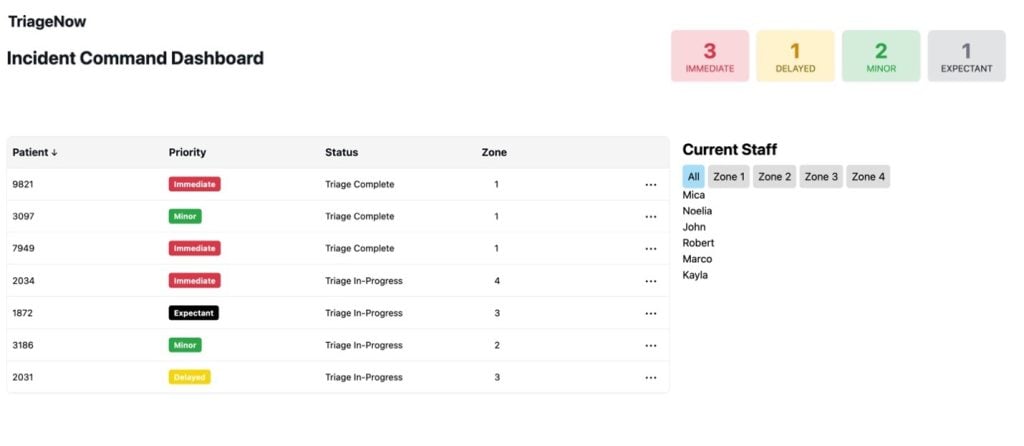
When seconds can mean the difference between life and death, first responders must rely on medical training, experience, and judgment to make quick decisions. Two teams of Johns Hopkins computer science students are working to help them do that better—one through an AI-powered training platform that helps EMTs practice decision-making, another through a digital system that streamlines patient tracking during mass casualty events.
The projects, RescueReady and TriageNow, came out of the Whiting School of Engineering’s two-semester Computer Science Innovation & Entrepreneurship course, designed to give third- and fourth-year undergraduate computer science students the skills to generate ideas for new ventures and prepare a business plan for an innovative technology of their own design. Both teams identified critical gaps in emergency medical services and built platforms aimed at saving lives by improving training and response efficiency.
The course is taught by Anton Dahbura, an associate research scientist in the Department of Computer Science, and Larry Aronhime, a teaching professor in WSE’s Center for Leadership Education. In late April, the students presented their projects at the Whiting School’s annual Design Day, as well as to an external panel comprising practitioners, industry representatives, and venture capitalists.
RescueReady—immersive scenario-based emergency training
Emergency medical technicians depend on both medical skills and situational awareness, but current EMS training focuses heavily on the former. Through interviews with local emergency medical services leadership and EMT advisors, computer science students Subhasri Vijay and Jamie Stelnik, Engr ’25, A&S ’25 discovered that EMTs learn vital situational awareness skills on the job—often through trial and error, which can lead to delayed decision-making, inefficient resource allocation, and increased risk for both patients and first responders. The students’ solution: RescueReady, an AI-driven training platform for practicing rapid, high-stakes decision-making in conditions that reflect real-world challenges.
“As an EMT, you’re going onto a scene and risking your life,” says Vijay, a fourth-year combined bachelor’s and master’s student of computer science minoring in computational medicine and entrepreneurship and management. “Training your thought process is imperative to the safety of you and those around you.”
She and Stelnik sought to develop a platform that gives first responders the ability to practice their situational awareness and decision-making skills in an infinite number of virtual emergency scenarios.
Using GTP 4.1’s prompting guides and base code from a homework solution in Associate Teaching Professor Ali Madooei‘s Full-Stack JavaScript course, the pair created an AI-driven scenario generator capable of simulating any emergency, fully customizable to different EMS roles and difficulty levels. The platform also provides instant feedback to help improve EMTs’ real-time decision-making skills and boasts features like station-based competitions and performance tracking to keep engagement high while reinforcing critical thinking under pressure.
Of course, no AI application is without its risks, such as AI’s potential to simply make up false or unhelpful content—called “hallucinations.” To combat this, the RescueReady team collaborated with EMS professionals to review and certify the platform’s AI-generated scenarios, implementing a rating system that allows users to “like” accurate scenarios or “flag” problematic ones to be regenerated or revised.
Currently, the team is working with local EMS agencies to test the system and gather feedback, all of which is “very positive so far,” Stelnik reports. The students’ goal is to integrate RescueReady into existing EMS systems in Maryland and beyond—an effort helped by the $1000 Pava Center for Entrepreneurship Award they earned at the 25th annual HopStart: Hopkins New Venture Challenge, where RescueReady additionally placed third in the competition’s General Ventures track.
But the team’s aspirations don’t stop there.
“Although we’re focusing on the EMS community right now, we envision expanding our platform to other industries that require high-stakes decisions and could benefit from situational awareness training,” Stelnik says.
“Building an app from scratch and launching it is something I never thought I’d do as part of my college career, but I’m so happy it turned out this way—I’m really proud of our implementation and seeing our success out there in the real world,” Vijay adds.
TriageNow—digital guidance for emergency patient response
Mass casualty incidents present extraordinary challenges, even for experienced first responders. When EMS resources are overwhelmed by the volume and severity of injuries, successfully triaging patients amidst this chaos can be a daunting task.
TriageNow, a real-time, user-friendly patient tracking platform that supports efficient note-taking and seamless information transfer, may offer a solution. The platform was developed by fourth-year CS majors Maria-Noelia Herne and Meghana Karthic, third-year CS major Kamila Wong, and fourth-year molecular and cellular biology major Micaela Rodriguez Steube.

The TriageNow team: Kamila Wong, Meghana Karthic, Maria-Noelia Herne, and Micaela Rodriguez Steub
Drawing on Steube’s background as a volunteer EMT and conversations with Matthew Levy—an associate professor of emergency medicine at the Johns Hopkins School of Medicine, the medical director of the Howard County Department of Fire & Rescue Services (HCDFRS), and the regional medical director for the Maryland Institute for Emergency Medical Services Systems—the team focused on two major challenges in MCI triage, communication and documentation.
“Currently, patient information is recorded on paper triage tags and communicated via handheld radios. These well-established but outdated systems can lead to information loss when tags are damaged or radio channels are congested with a high volume of messages,” Steube explains. “As a result, resources may not be efficiently allocated and patients could lose critical time waiting for lifesaving care.”
Rather than abandon these conventions entirely, the students came up with a hybrid solution that incorporates digital efficiency: TriageNow enables first responders to use color-coded wristbands to visually communicate a patient’s condition—but now they’ll be accompanied by scannable barcodes, much like the ones used in hospitals, that can be used to create a digital profile for each patient. EMTs can then use the system’s guided triage algorithm for clinical decision-making and its voice-to-text feature to document patient care details efficiently and accurately while keeping their hands free to deliver critical care.
The platform feeds patient information in real time to a centralized dashboard available to incident commanders, the EMS personnel in charge of the scene. Instead of getting updates by radio, they can see at a glance the number of patients affected by the event, the severity of their conditions, and each patient’s stage of care, allowing commanders to make more informed decisions about resource allocation.

TriageNow’s Incident Command Dashboard interface
To test their system, the students conducted a drill with the Hopkins Emergency Response Organization, whose volunteers reported that the software enabled them to assess patients more quickly and move through triage workflows with more ease and efficiency.
With this success under their belt, the group will move on to pilot TriageNow with HCDFRS, using a focused approach to ensure all MCI-specific needs are met before expanding the system to aid with resource allocation and information flow for all EMS responses—not just multi-patient events—and integrating it with existing hospital workflows.
The team’s ultimate vision? Scaling the system nationally across 23,000 EMS agencies. Per Steube, “Our goal is to make TriageNow the new standard in MCI response, maximizing lives saved.”